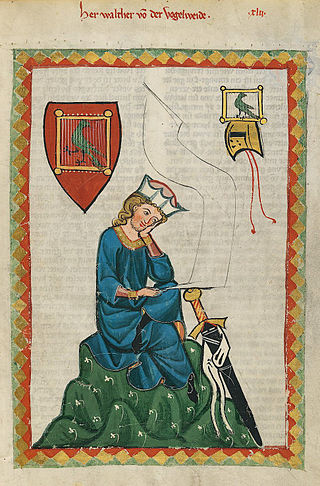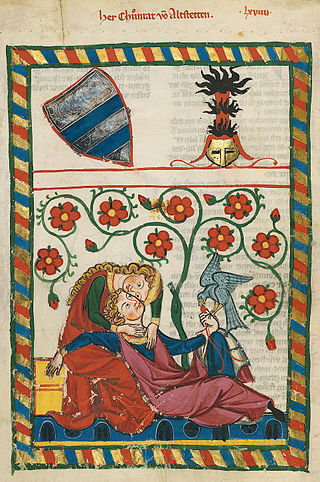
The Codex Manesse is a Liederhandschrift, the single most comprehensive source of Middle High German Minnesang poetry, written and illustrated between c. 1304 when the main part was completed, and c. 1340 with the addenda.

Minnesang was a tradition of lyric- and song-writing in Germany and Austria that flourished in the Middle High German period. This period of medieval German literature began in the 12th century and continued into the 14th. People who wrote and performed Minnesang were known as Minnesänger, and a single song was called a Minnelied.

Walther von der Vogelweide was a Minnesänger who composed and performed love-songs and political songs ("Sprüche") in Middle High German. Walther has been described as the greatest German lyrical poet before Goethe; his hundred or so love-songs are widely regarded as the pinnacle of Minnesang, the medieval German love lyric, and his innovations breathed new life into the tradition of courtly love. He was also the first political poet to write in German, with a considerable body of encomium, satire, invective, and moralising.

Neidhartc. 1190 – c. 1240 was one of the most famous Minnesänger. With around 1500 documented strophes of his songs surviving, Neidhart has the largest corpus of surviving lyrics of any Minnesänger, suggesting the great popularity of the songs. In addition, and quite unlike any of his contemporaries, many melodies to his songs have been preserved: manuscripts have almost 70 melodies to 55 of his songs.

Heinrich von Ofterdingen is a fabled, quasi-fictional Middle High German lyric poet and Minnesinger mentioned in the 13th-century epic of the Sängerkrieg on the Wartburg. The legend was revived by Novalis in his eponymous fragmentary novel written in 1800 and by E. T. A. Hoffmann in his 1818 novella Der Kampf der Sänger.

Heinrich von Morungen was a Minnesinger, whose 35 surviving Middle High German songs are dated on both literary and biographical grounds to around the period 1190–1200. Alongside Walter von der Vogelweide and Reinmar he is regarded as one of the most important Minnesänger: he was "the most colourful, passionate, tender and musical of the Minnesänger" and his work "marks a new and brilliantly effective stage in the development of the German lyric."

Der von Kürenberg or Der Kürenberger was a Middle High German poet and one of the earliest Minnesänger. Fifteen strophes of his songs are preserved in the Codex Manesse and the Budapest Fragment.

The Palästinalied is a crusade song written in the early 13th century by Walther von der Vogelweide, the most celebrated lyric poet of Middle High German literature. It is one of the few songs by Walther for which a melody has survived.

Reinmar von Zweter was a Middle High German poet of Spruchdichtung. The iconography in the Manesse Codex suggests that he may have been blind, since he is the only person represented in the manuscript with closed eyes and other people writing. The caption, not shown here, of that miniature refers to him as "Herr" Reinmar, implying that he was a knight and that he became blind in adulthood.

Reinmar von Hagenau was a German Minnesänger of the late twelfth century who composed and performed love-songs in Middle High German. He was regarded by his contemporaries as the greatest Minnesänger before Walther von der Vogelweide, a view widely shared by modern scholars. Although there are uncertainties as to which songs can be reliably attributed to him, a substantial body of his work — over 60 songs — survives. His presentation of courtly love as the unrequited love of a knight for a lady is "the essence of classical Minesang".

"Under der linden" is a well-known poem written by the medieval German lyric poet Walther von der Vogelweide. It is written in Middle High German. The song may have originally been sung to the surviving melody of an old French song, which matches the meter of the poem.

Bernger von Horheim was a Rhenish Minnesänger of the late twelfth century. He wrote in the tradition of courtly love and was influenced by Friedrich von Hausen.
Middle High German literature refers to literature written in German between the middle of the 11th century and the middle of the 14th. In the second half of the 12th century, there was a sudden intensification of activity, leading to a 60-year "golden age" of medieval German literature referred to as the mittelhochdeutsche Blütezeit. This was the period of the blossoming of Minnesang, MHG lyric poetry, initially influenced by the French and Provençal tradition of courtly love song. The same sixty years saw the composition of the most important courtly romances. again drawing on French models such as Chrétien de Troyes, many of them relating Arthurian material. The third literary movement of these years was a new revamping of the heroic tradition, in which the ancient Germanic oral tradition can still be discerned, but tamed and Christianized and adapted for the court.

Reinmar von Brennenberg was a minnesinger and ministerialis to the Bishop of Regensburg in the 13th century.

Meinloh von Sevelingen was a 12th-century Minnesänger from Swabia and one of the earliest poets in the tradition.

The Kleine Heidelberger Liederhandschift is a collection of Middle High German Minnesang texts. In Minnesang scholarship it is referred to as MS. A. It is held by the Heidelberg University Library with the signature Cod.Pal.germ. 357.

The Burggraf von Regensburg was a Middle High German lyric poet who wrote Minnelieder. In his four surviving stanzas, love is not yet courtly love. In one, strongly contrary to later courtly convention, the woman serves the man. All his stanzas are preserved in two manuscripts, the 13th-century Kleine Heidelberger Liederhandschrift and the 14th-century Codex Manesse.

Konrad von Altstetten was a German petty nobleman and Middle High German lyric poet in the Minnesang tradition. He belonged to a family of vassals of the Abbey of Saint Gall, based in Altstätten. His poetry, light in style, was influenced by Gottfried von Neifen. Three of his songs are preserved in the Codex Manesse.

Gottfried von Neifen was a German Minnesänger.

Kristan von Hamle was a Middle High German poet from Thuringia who flourished in the mid-thirteenth century. Nothing is known about his life or his family, as he has not been identified in any documentary record.

















